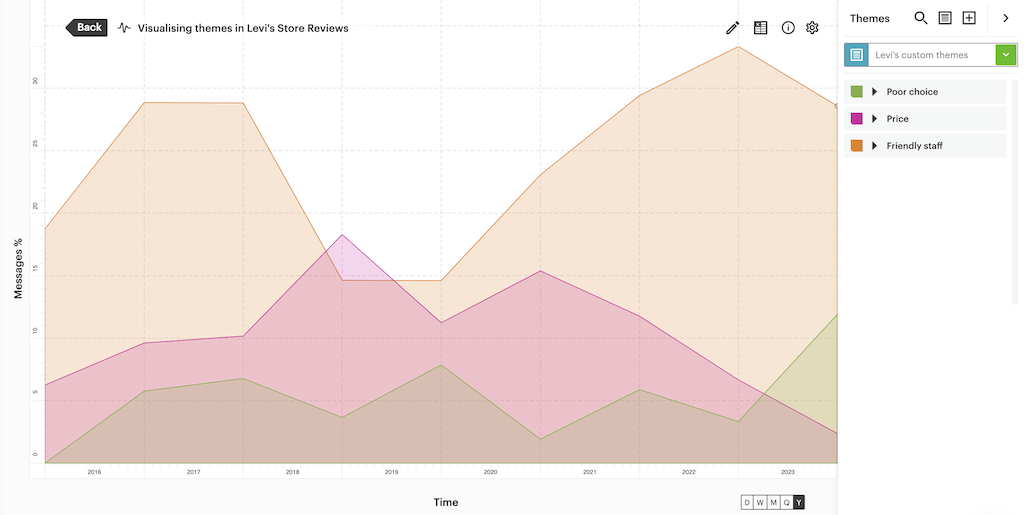Identifying what customers think about Levi’s in-store experience

In-store experience is a defining element of in-person shopping. With most products accessible through an easy click or tap, customers need a reason to physically visit your store.
Your retail experience is a continuous effort. Your store must evolve as customer wants and desires change. Therefore, it’s vital to track what these wants and desires are.
Tracking how these opinions change over time ensures you make the right adjustments to your in-store experience. Failure to do this leads to reduced footfall, and reduced in-store sales as a consequence.
Having a way to capture, analyze and act on retail feedback is crucial. Regular customer satisfaction surveys or NPS feedback questionnaires are common ways to obtain customers’ thoughts. However, there are other forums where shoppers can express their opinions, such as review sites.
To demonstrate how to go about this type of tracking, Relative Insight analyzed reviews from Levi’s flagship store in San Francisco. By separating respondents into promoters and detractors, as well as analyzing data over time, we pinpointed the factors that led customers to have a great in-store experience — as well as highlight areas of improvement.
Staff and tailoring key to in-store experience
Customers leaving positive reviews celebrated the store’s staff. Promoters were 5.0x more likely to talk about their interactions with Levi’s employees.
These reviews used words related to ‘friendliness’ 4.5x more, including ‘friendly’, ‘courteous’ and ‘approachable’. Customers leaving good reviews also used the word ‘helpful’ 3.5x more, as well as the phrases ‘attentive staff’ and ‘friendly staff’ infinitely more — meaning these phrases didn’t feature in negative feedback.
“The staff were incredibly friendly and helpful. It was probably my best shopping experience ever. Manuela made me feel like a VIP and I ended up walking out with three new pairs of jeans.“
There was one particular group of employees who really impressed customers — the in-store tailors. Positive reviews talked about the ‘tailor’ infinitely more, with customers highlighting tailors’ skill, along with their knowledge and recommendations. Some reviewers even praised the tailors by name.
“Had custom jeans made from the tailor team. August is a legend. Made an exceptional pair of custom jeans.“
What’s apparent from promoters’ reviews is that Levi’s San Francisco outlet provides an in-store experience that goes beyond the transactional. Shoppers are made to feel special by staff, and the inclusion of an on-site tailor delights customers.
Operational challenges irk detractors
While the store’s promoters praised in-store experience, detractors raised operational issues that impacted their view of the store.
Price was a key sticking point for negative reviewers. They were 6.4x more likely to describe the jeans as ‘expensive’ and talked about ‘cost’ 11.4x more.
What irked them was how much Levi’s jeans cost compared with nearby department stores. This group talked about ‘Macy’s’ infinitely more, highlighting that they could buy Levi’s jeans from the nearby Macy’s at a much lower price.
“They tried to charge me $90 for a pair of jeans that cost $60 at Macy’s across the street. Don’t waste your money.“
Part of the issue with cost related to available stock. Detractors were 5.8x more likely to complain about the lack of ‘sizes’, as well as discussing limited ‘choice’ 1.1x more. They were also infinitely more likely talk about ‘poor’ or ‘low selections’ of jeans.
“It’s incredible that despite being the flagship Levi’s store worldwide, they don’t carry all sizes and models. I came here with my husband to find a specific style and a size, somehow they were difficult to find; we had no luck.“
From the perspective of providing an innovative and imaginative in-store experience, Levi’s San Francisco performs well. However, detractors’ comments show that the store can improve its bread-and-butter operations.
Tracking customer feedback over time
Knowing what matters most to customers visiting your store is vital. However, being able to track this over time is even more important. It illustrates the effectiveness of any action you’ve taken, plus highlights emerging areas you need to address.
We built the findings from our analysis of Levi’s San Francisco reviews into our longitudinal visualization tool — Heartbeat. These are illustrated by three themes: friendly staff, price and poor choice.


With promoters outweighing detractors, it’s unsurprising that staff friendliness – prominent in positive reviews – dominates. However, in the lead up to the pandemic, there’s a clear fall in reviewers discussing this theme, before rising dramatically in 2020 and beyond.
Of the two issues raised by detractors, there’s a clear spike in customers complaining about product availability in 2023 and 2024. Conversely, despite inflation becoming a major economic issue across the country, complaints around pricing fell after 2021.
Therefore, the key issue detracting from in-store experience in 2024 is choice of jeans, rather than price.
Taking action to improve in-store experience
Pinpointing what’s working and what isn’t is the first step in improving customer engagement. However, the vital second step is to take action.
Levi’s store in San Francisco is rated 4.2/5 on Google. Therefore, rather than drastic changes, the team can make iterative improvements to boost a great score even higher.
The first area store management must look to is staff friendliness. These interactions are driving positive in-store experience for shoppers, therefore maintaining friendliness should be top priority.
The small fall in customers talking about staff friendliness in 2024 reviews should act as a warning; failure to address this decline could see happiness with staff fall to pre-pandemic levels — with an associated drop in review score and revenue.
Secondly, the store needs to address product availability. The number of reviewers highlighting this issue is on the rise, meaning this challenge could begin to erode customers’ blissful in-store experience.
With customers stating that there are other stores nearby with a greater selection of Levi’s jeans, failure to improve choice risks shoppers electing to buy elsewhere.
Understanding what customers love and hate about their in-store experience is the difference between increasing or losing revenue. Relative Insight’s software tells you why they’re giving specific NPS, CSAT and other customer scores, enabling you to improve customers’ experience.
